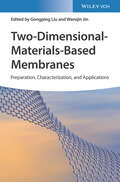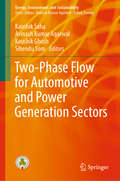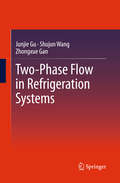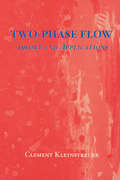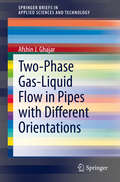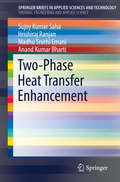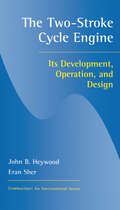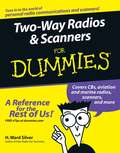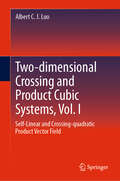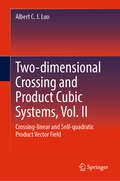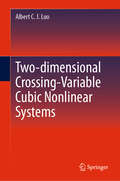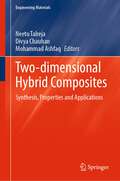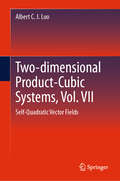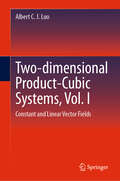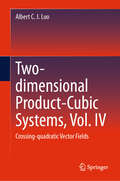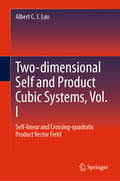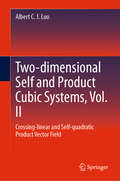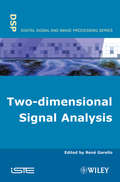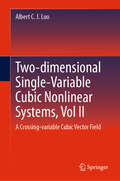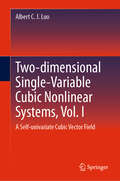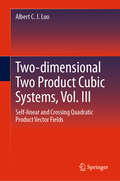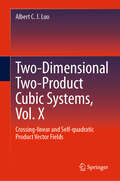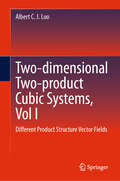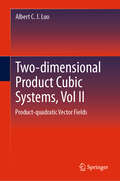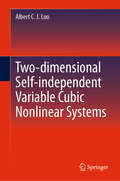- Table View
- List View
Two-Dimensional-Materials-Based Membranes: Preparation, Characterization, and Applications
by Gongping LiuTwo-Dimensional-Materials-Based Membranes An authoritative and up to date discussion of two-dimensional materials and membranes In Two-Dimensional-Materials-Based Membranes: Preparation, Characterization, and Applications, a team of distinguished chemical engineers delivers a comprehensive exploration of the latest advances in design principles, synthesis approaches, and applications of two-dimensional (2D) materials—like graphene, metal-organic frameworks (MOFs), 2D layered double hydroxides, and MXene—and highlights the significance and development of these membranes. In the book, the authors discuss the use of membranes to achieve high-efficiency separation and to address the challenges posed in the field. The book also discusses potential challenges and benefits in the future development of advanced 2D nanostructures, as well as their impending implementation in applications in the fields of energy, sustainability, catalysis, electronics, and biotechnology. Readers will also find: A thorough introduction to fabrication methods for 2D-materials-based membranes, including the synthesis of nanosheets, membrane structures, and fabrication methods Descriptions of three types of 2D-materials-based membranes: single-layer membranes, laminar membranes and mixed-matrix membranes Comprehensive discussions of 2D-materials-based membranes for water and ions separation, solvent-water separation and gas separation Explorations of transport mechanism of 2D-materials-based membranes for molecular separations Perfect for membrane scientists, inorganic chemists, and materials scientists, Two-Dimensional-Materials-Based Membranes will also earn a place in the libraries of chemical and process engineers in industrial environments.
Two-Phase Flow for Automotive and Power Generation Sectors (Energy, Environment, and Sustainability)
by Avinash Kumar Agarwal Kaushik Saha Koushik Ghosh Sibendu SomThis book focuses on the two-phase flow problems relevant in the automotive and power generation sectors. It includes fundamental studies on liquid–gas two-phase interactions, nucleate and film boiling, condensation, cavitation, suspension flows as well as the latest developments in the field of two-phase problems pertaining to power generation systems. It also discusses the latest analytical, numerical and experimental techniques for investigating the role of two-phase flows in performance analysis of devices like combustion engines, gas turbines, nuclear reactors and fuel cells. The wide scope of applications of this topic makes this book of interest to researchers and professionals alike.
Two-Phase Flow in Refrigeration Systems
by Junjie Gu Zhongxue Gan Shujun WangTwo-Phase Flow in Refrigeration Systems presents recent developments from the authors' extensive research programs on two-phase flow in refrigeration systems. This book covers advanced mass and heat transfer and vapor compression refrigeration systems and shows how the performance of an automotive air-conditioning system is affected through results obtained experimentally and theoretically, specifically with consideration of two-phase flow and oil concentration. The book is ideal for university postgraduate students as a textbook, researchers and professors as an academic reference book, and by engineers and designers as handbook.
Two-Phase Flow: Theory and Applications
by Cl KleinstreuerThis graduate text provides a unified treatment of the fundamental principles of two-phase flow and shows how to apply the principles to a variety of homogeneous mixture as well as separated liquid-liquid, gas-solid, liquid-solid, and gas-liquid flow problems, which may be steady or transient, laminar or turbulent.Each chapter contains several sample problems, which illustrate the outlined theory and provide approaches to find simplified analytic descriptions of complex two-phase flow phenomena.This well-balanced introductory text will be suitable for advanced seniors and graduate students in mechanical, chemical, biomedical, nuclear, environmental and aerospace engineering, as well as in applied mathematics and the physical sciences. It will be a valuable reference for practicing engineers and scientists. A solutions manual is available to qualified instructors.
Two-Phase Gas-Liquid Flow in Pipes with Different Orientations (SpringerBriefs in Applied Sciences and Technology)
by Afshin J. GhajarThis book provides design engineers using gas-liquid two-phase flow in different industrial applications the necessary fundamental understanding of the two-phase flow variables. Two-phase flow literature reports a plethora of correlations for determination of flow patterns, void fraction, two- phase pressure drop and non-boiling heat transfer correlations. However, the validity of a majority of these correlations is restricted over a narrow range of two -phase flow conditions. Consequently, it is quite a challenging task for the end user to select an appropriate correlation/model for the type of two-phase flow under consideration. Selection of a correct correlation also requires some fundamental understanding of the two-phase flow physics and the underlying principles/assumptions/limitations associated with these correlations. Thus, it is of significant interest for a design engineer to have knowledge of the flow patterns and their transitions and their influence on two-phase flow variables. To address some of these issues and facilitate selection of appropriate two-phase flow models, this volume presents a succinct review of the flow patterns, void fraction, pressure drop and non-boiling heat transfer phenomenon and recommend some of the well scrutinized modeling techniques.
Two-Phase Heat Transfer Enhancement (SpringerBriefs in Applied Sciences and Technology)
by Sujoy Kumar Saha Hrishiraj Ranjan Madhu Sruthi Emani Anand Kumar BhartiThis Brief concerns heat transfer and pressure drop in heat transfer enhancement for boiling and condensation. The authors divide their topic into six areas: abrasive treatment and coatings, combined structured and porous surfaces, basic principles of boiling mechanism, vapor space condensation, convective vaporization, and forced condensation inside tubes. Within this framework, the book examines range of specific phenomena including abrasive treatment, open grooves, 3D cavities, etched surfaces, electroplating, pierced 3D cover sheets, attached wire and screen promoters, non-wetting coatings, oxide and ceramic coatings, porous surfaces, structured surfaces (integral roughness), combined structured and porous surfaces, composite surfaces, single-tube pool boiling tests, theoretical fundamentals like liquid superheat, effect of cavity shape and contact angle on superheat, entrapment of vapor in cavities, nucleation at a surface cavity, effect of dissolved gases, bubble departure diameter, bubble dynamics, boiling hysteresis and orientation effects, basic principles of boiling mechanism, visualization and mechanism of boiling in subsurface tunnels, and Chien and Webb parametric boiling studies.
Two-Stroke Cycle Engine: Its Development, Operation and Design (Combustion)
by JohnB. HeywoodThis book addresses the two-stroke cycle internal combustion engine, used in compact, lightweight form in everything from motorcycles to chainsaws to outboard motors, and in large sizes for marine propulsion and power generation. It first provides an overview of the principles, characteristics, applications, and history of the two-stroke cycle engine, followed by descriptions and evaluations of various types of models that have been developed to predict aspects of two-stroke engine operation.
Two-Way Radios and Scanners For Dummies
by H. Ward SilverDiscover a fun new hobby with helpful possibilities Get directions, talk to folks overseas, or find out whether the fish are biting Want to check out the morning news in London, help out in emergencies, or tune in to the big race? Two-way radios open up a world of possibilities - literally. This handy guide tells you about the equipment you need, fills you in on radio etiquette, shows you how to stay legal, and gives you lots of cool ideas for family-friendly radio activities. Discover how to * Use the right radio lingo * Choose and operate different types of radios * Get a license if you need one * Communicate in emergencies * Program a scanner * Tune in to sporting events
Two-dimensional Crossing and Product Cubic Systems, Vol. I: Self-linear and Crossing-quadratic Product Vector Field
by Albert C. LuoThis book, the 14th of 15 related monographs on Cubic Dynamical Systems, discusses crossing and product cubic systems with a self-linear and crossing-quadratic product vector field. Dr. Luo discusses singular equilibrium series with inflection-source (sink) flows that are switched with parabola-source (sink) infinite-equilibriums. He further describes networks of simple equilibriums with connected hyperbolic flows are obtained, which are switched with inflection-source (sink) and parabola-saddle infinite-equilibriums, and nonlinear dynamics and singularity for such crossing and product cubic systems. In such cubic systems, the appearing bifurcations are: - double-inflection saddles, - inflection-source (sink) flows, - parabola-saddles (saddle-center), - third-order parabola-saddles, - third-order saddles and centers.
Two-dimensional Crossing and Product Cubic Systems, Vol. II: Crossing-linear and Self-quadratic Product Vector Field
by Albert C. LuoThis book, the 15th of 15 related monographs on Cubic Dynamic Systems, discusses crossing and product cubic systems with a crossing-linear and self-quadratic product vector field. The author discusses series of singular equilibriums and hyperbolic-to-hyperbolic-scant flows that are switched through the hyperbolic upper-to-lower saddles and parabola-saddles and circular and hyperbolic upper-to-lower saddles infinite-equilibriums. Series of simple equilibrium and paralleled hyperbolic flows are also discussed, which are switched through inflection-source (sink) and parabola-saddle infinite-equilibriums. Nonlinear dynamics and singularity for such crossing and product cubic systems are presented. In such cubic systems, the appearing bifurcations are: parabola-saddles, hyperbolic-to-hyperbolic-secant flows, third-order saddles (centers) and parabola-saddles (saddle-center).
Two-dimensional Crossing-Variable Cubic Nonlinear Systems
by Albert C. LuoThis book is the fourth of 15 related monographs presents systematically a theory of crossing-cubic nonlinear systems. In this treatment, at least one vector field is crossing-cubic, and the other vector field can be constant, crossing-linear, crossing-quadratic, and crossing-cubic. For constant vector fields, the dynamical systems possess 1-dimensional flows, such as parabola and inflection flows plus third-order parabola flows. For crossing-linear and crossing-cubic systems, the dynamical systems possess saddle and center equilibriums, parabola-saddles, third-order centers and saddles (i.e, (3rd UP+:UP+)-saddle and (3rdUP-:UP-)-saddle) and third-order centers (i.e., (3rd DP+:DP-)-center, (3rd DP-, DP+)-center) . For crossing-quadratic and crossing-cubic systems, in addition to the first and third-order saddles and centers plus parabola-saddles, there are (3:2)parabola-saddle and double-inflection saddles, and for the two crossing-cubic systems, (3:3)-saddles and centers exist. Finally,the homoclinic orbits with centers can be formed, and the corresponding homoclinic networks of centers and saddles exist. Readers will learn new concepts, theory, phenomena, and analytic techniques, including · Constant and crossing-cubic systems · Crossing-linear and crossing-cubic systems · Crossing-quadratic and crossing-cubic systems · Crossing-cubic and crossing-cubic systems · Appearing and switching bifurcations · Third-order centers and saddles · Parabola-saddles and inflection-saddles · Homoclinic-orbit network with centers · Appearing bifurcations
Two-dimensional Hybrid Composites: Synthesis, Properties and Applications (Engineering Materials)
by Neetu Talreja Divya Chauhan Mohammad AshfaqThis book highlights a comprehensive review of synthesis, properties, and strategies to improve the applicability of 2D materials like graphene, borophenes, metal nanosheets, phosphorene, and transition metal dichalcogenides (TMDs). It also highlights the synthesis of 2D-based hybrid composite materials and their effects on applicability, especially in energy, environment, and biomedical applications, by incorporating surface functional groups, metal/non-metal ions, and polymers. The advancement in innovative technology and use of 2D-based hybrid composite materials can improve the development of newer products/opening newer possibilities to fight existing issues related to environment, energy, and biomedical sciences. However, researchers continue to face numerous challenges in developing newer products/possibilities, large-scale production, with health and environmental impact being a challenge.This book serves as a valuable resource for researchers, professionals and students working in the field of advanced materials, especially 2D-based hybrid composites.
Two-dimensional Product Cubic Systems, Vol. VII: Self- Quadratic Vector Fields
by Albert C. LuoThis book is the seventh of 15 related monographs, concerns nonlinear dynamics and singularity of cubic dynamical systems possessing a product-cubic vector field and a self-univariate quadratic vector field. The equilibrium singularity and bifurcation dynamics are discussed. The saddle-source (sink) is the appearing bifurcations for saddle and source (sink). The double-saddle equilibriums are the appearing bifurcations of the saddle-source and saddle-sink, and also the appearing bifurcations of the network of saddles, sink and source. The infinite-equilibriums for the switching bifurcations include: • inflection-saddle infinite-equilibriums, • hyperbolic-source (sink) infinite-equilibriums, • up-down (down-up) saddle infinite-equilibriums, • inflection-source (sink) infinite-equilibriums.
Two-dimensional Product-Cubic Systems, Vol. I: Constant and Linear Vector Fields
by Albert C. LuoThis book, the fifth of 15 related monographs, presents systematically a theory of product-cubic nonlinear systems with constant and single-variable linear vector fields. The product-cubic vector field is a product of linear and quadratic different univariate functions. The hyperbolic and hyperbolic-secant flows with directrix flows in the cubic product system with a constant vector field are discussed first, and the cubic product systems with self-linear and crossing-linear vector fields are discussed. The inflection-source (sink) infinite equilibriums are presented for the switching bifurcations of a connected hyperbolic flow and saddle with hyperbolic-secant flow and source (sink) for the connected the separated hyperbolic and hyperbolic-secant flows. The inflection-sink and source infinite-equilibriums with parabola-saddles are presented for the switching bifurcations of a separated hyperbolic flow and saddle with a hyperbolic-secant flow and center. Readers learn new concepts, theory, phenomena, and analysis techniques, such as Constant and product-cubic systems, Linear-univariate and product-cubic systems, Hyperbolic and hyperbolic-secant flows, Connected hyperbolic and hyperbolic-secant flows, Separated hyperbolic and hyperbolic-secant flows, Inflection-source (sink) Infinite-equilibriums and Infinite-equilibrium switching bifurcations.
Two-dimensional Product-Cubic Systems, Vol. IV: Crossing-quadratic Vector Fields
by Albert C. LuoThis book, the eighth of 15 related monographs, discusses a product-cubic dynamical system possessing a product-cubic vector field and a crossing-univariate quadratic vector field. It presents equilibrium singularity and bifurcation dynamics, and . the saddle-source (sink) examined is the appearing bifurcations for saddle and source (sink). The double-inflection saddle equilibriums are the appearing bifurcations of the saddle and center, and also the appearing bifurcations of the network of saddles and centers. The infinite-equilibriums for the switching bifurcations featured in this volume include: Parabola-source (sink) infinite-equilibriums, Inflection-source (sink) infinite-equilibriums, Hyperbolic (circular) sink-to source infinite-equilibriums, Hyperbolic (circular) lower-to-upper saddle infinite-equilibriums.
Two-dimensional Self and Product Cubic Systems, Vol. I: Self-linear and Crossing-quadratic Product Vector Field
by Albert C. LuoThis book, the 14th of 15 related monographs on Cubic Dynamical Systems, discusses crossing and product cubic systems with a self-linear and crossing-quadratic product vector field. Dr. Luo discusses singular equilibrium series with inflection-source (sink) flows that are switched with parabola-source (sink) infinite-equilibriums. He further describes networks of simple equilibriums with connected hyperbolic flows are obtained, which are switched with inflection-source (sink) and parabola-saddle infinite-equilibriums, and nonlinear dynamics and singularity for such crossing and product cubic systems. In such cubic systems, the appearing bifurcations are: double-inflection saddles, inflection-source (sink) flows, parabola-saddles (saddle-center), third-order parabola-saddles, third-order saddles (centers), third-order saddle-source (sink).
Two-dimensional Self and Product Cubic Systems, Vol. II: Crossing-linear and Self-quadratic Product Vector Field
by Albert C. LuoThis book is the thirteenth of 15 related monographs on Cubic Dynamical Systems, discusses self- and product-cubic systems with a crossing-linear and self-quadratic products vector field. Equilibrium series with flow singularity are presented and the corresponding switching bifurcations are discussed through up-down saddles, third-order concave-source (sink), and up-down-to-down-up saddles infinite-equilibriums. The author discusses how equilibrium networks with paralleled hyperbolic and hyperbolic-secant flows exist in such cubic systems, and the corresponding switching bifurcations obtained through the inflection-source and sink infinite-equilibriums. In such cubic systems, the appearing bifurcations are: saddle-source (sink) hyperbolic-to-hyperbolic-secant flows double-saddle third-order saddle, sink and source third-order saddle-source (sink)
Two-dimensional Signal Analysis
by René GarelloThis title sets out to show that 2-D signal analysis has its own role to play alongside signal processing and image processing. Concentrating its coverage on those 2-D signals coming from physical sensors (such as radars and sonars), the discussion explores a 2-D spectral approach but develops the modeling of 2-D signals and proposes several data-oriented analysis techniques for dealing with them. Coverage is also given to potential future developments in this area.
Two-dimensional Single-Variable Cubic Nonlinear Systems, Vol II: A Crossing-variable Cubic Vector Field
by Albert C. LuoThis book, the second of 15 related monographs, presents systematically a theory of cubic nonlinear systems with single-variable vector fields. The cubic vector fields are of crossing-variables, which are discussed as the second part. The 1-dimensional flow singularity and bifurcations are discussed in such cubic systems. The appearing and switching bifurcations of the 1-dimensional flows in such 2-diemnsional cubic systems are for the first time to be presented. Third-order parabola flows are presented, and the upper and lower saddle flows are also presented. The infinite-equilibriums are the switching bifurcations for the first and third-order parabola flows, and inflection flows with the first source and sink flows, and the upper and lower-saddle flows. The appearing bifurcations in such cubic systems includes inflection flows and third-order parabola flows, upper and lower-saddle flows. Readers will learn new concepts, theory, phenomena, and analytic techniques, including Constant and crossing-cubic systems Crossing-linear and crossing-cubic systems Crossing-quadratic and crossing-cubic systems Crossing-cubic and crossing-cubic systems Appearing and switching bifurcations Third-order centers and saddles Parabola-saddles and inflection-saddles Homoclinic-orbit network with centers Appearing bifurcations
Two-dimensional Single-Variable Cubic Nonlinear Systems, Vol. I: A Self-univariate Cubic Vector Field
by Albert C. LuoThis book is the first of 15 related monographs, presents systematically a theory of cubic nonlinear systems with single-variable vector fields. The cubic vector fields are of self-variables and are discussed as the first part of the book. The 1-dimensional flow singularity and bifurcations are discussed in such cubic systems. The appearing and switching bifurcations of the 1-dimensional flows in such 2-dimensional cubic systems are for the first time to be presented. Third-order source and sink flows are presented, and the third-order parabola flows are also presented. The infinite-equilibriums are the switching bifurcations for the first and third-order source and sink flows, and the second-order saddle flows with the first and third-order parabola flows, and the inflection flows. The appearing bifurcations in such cubic systems includes saddle flows and third-order source (sink) flows, inflection flows and third-order up (down)-parabola flows.
Two-dimensional Two Product Cubic Systems, Vol. III: Self-linear and Crossing Quadratic Product Vector Fields
by Albert C. LuoThis book is the eleventh of 15 related monographs on Cubic Systems, examines self-linear and crossing-quadratic product systems. It discusses the equilibrium and flow singularity and bifurcations, The double-inflection saddles featured in this volume are the appearing bifurcations for two connected parabola-saddles, and also for saddles and centers. The parabola saddles are for the appearing bifurcations of saddle and center. The inflection-source and sink flows are the appearing bifurcations for connected hyperbolic and hyperbolic-secant flows. Networks of higher-order equilibriums and flows are presented. For the network switching, the inflection-sink and source infinite-equilibriums exist, and parabola-source and sink infinite-equilibriums are obtained. The equilibrium networks with connected hyperbolic and hyperbolic-secant flows are discussed. The inflection-source and sink infinite-equilibriums are for the switching bifurcation of two equilibrium networks.
Two-dimensional Two-product Cubic Systems Vol. X: Crossing-linear and Self-quadratic Product Vector Fields
by Albert C. LuoThis book is the tenth of 15 related monographs, discusses product-cubic nonlinear systems with two crossing-linear and self-quadratic products vector fields and the dynamic behaviors and singularity are presented through the first integral manifolds. The equilibrium and flow singularity and bifurcations discussed in this volume are for the appearing and switching bifurcations. The double-saddle equilibriums described are the appearing bifurcations for saddle source and saddle-sink, and for a network of saddles, sink and source. The infinite-equilibriums for the switching bifurcations are also presented, specifically: · Inflection-saddle infinite-equilibriums, · Hyperbolic (hyperbolic-secant)-sink and source infinite-equilibriums · Up-down and down-up saddle infinite-equilibriums, · Inflection-source (sink) infinite-equilibriums.
Two-dimensional Two-product Cubic Systems, Vol I: Different Product Structure Vector Fields
by Albert C. LuoThis book is the ninth of 15 related monographs, discusses a two product-cubic dynamical system possessing different product-cubic structures and the equilibrium and flow singularity and bifurcations for appearing and switching bifurcations. The appearing bifurcations herein are parabola-saddles, saddle-sources (sinks), hyperbolic-to-hyperbolic-secant flows, and inflection-source (sink) flows. The switching bifurcations for saddle-source (sink) with hyperbolic-to-hyperbolic-secant flows and parabola-saddles with inflection-source (sink) flows are based on the parabola-source (sink), parabola-saddles, inflection-saddles infinite-equilibriums. The switching bifurcations for the network of the simple equilibriums with hyperbolic flows are parabola-saddles and inflection-source (sink) on the inflection-source and sink infinite-equilibriums. Readers will learn new concepts, theory, phenomena, and analysis techniques. · Two-different product-cubic systems · Hybrid networks of higher-order equilibriums and flows · Hybrid series of simple equilibriums and hyperbolic flows · Higher-singular equilibrium appearing bifurcations · Higher-order singular flow appearing bifurcations · Parabola-source (sink) infinite-equilibriums · Parabola-saddle infinite-equilibriums · Inflection-saddle infinite-equilibriums · Inflection-source (sink) infinite-equilibriums · Infinite-equilibrium switching bifurcations.
Two-dimensional Product-cubic Systems, Vol.II: Product-quadratic Vector Fields
by Albert C. LuoThis book, the sixth of 15 related monographs, discusses singularity and networks of equilibriums and 1-diemsnional flows in product quadratic and cubic systems. The author explains how, in the networks, equilibriums have source, sink and saddles with counter-clockwise and clockwise centers and positive and negative saddles, and the 1-dimensional flows includes source and sink flows, parabola flows with hyperbolic and hyperbolic-secant flows. He further describes how the singular equilibriums are saddle-source (sink) and parabola-saddles for the appearing bifurcations, and the 1-dimensional singular flows are the hyperbolic-to-hyperbolic-secant flows and inflection source (sink) flows for 1-dimensional flow appearing bifurcations, and the switching bifurcations are based on the infinite-equilibriums, including inflection-source (sink), parabola-source (sink), up-down and down-up upper-saddle (lower-saddle), up-down (down-up) sink-to-source and source-to-sink, hyperbolic and hyperbolic-secant saddles. The diagonal-inflection upper-saddle and lower-saddle infinite-equilibriums are for the double switching bifurcations. The networks of hyperbolic flows with connected saddle, source and center are presented, and the networks of the hyperbolic flows with paralleled saddle and center are also illustrated. Readers will learn new concepts, theory, phenomena, and analysis techniques. Product-quadratic and product cubic systems Self-linear and crossing-quadratic product vector fields Self-quadratic and crossing-linear product vector fields Hybrid networks of equilibriums and 1-dimensional flows Up-down and down-up saddle infinite-equilibriums Up-down and down-up sink-to-source infinite-equilibriums Inflection-source (sink) Infinite-equilibriums Diagonal inflection saddle infinite-equilibriums Infinite-equilibrium switching bifurcations
Two-dimensional Self-independent Variable Cubic Nonlinear Systems
by Albert C. LuoThis book, the third of 15 related monographs, presents systematically a theory of self-independent cubic nonlinear systems. Here, at least one vector field is self-cubic, and the other vector field can be constant, self-linear, self-quadratic, or self-cubic. For constant vector fields in this book, the dynamical systems possess 1-dimensional flows, such as source, sink and saddle flows, plus third-order source and sink flows. For self-linear and self-cubic systems discussed, the dynamical systems possess source, sink and saddle equilibriums, saddle-source and saddle-sink, third-order sink and source (i.e, (3rd SI:SI)-sink and (3rdSO:SO)-source) and third-order source (i.e., (3rd SO:SI)-saddle, (3rd SI, SO)-saddle) . For self-quadratic and self-cubic systems, in addition to the first and third-order sink, source and saddles plus saddle-source and saddle-sink, there are (3:2)-saddle-sink and (3:2) saddle-source and double-saddles. For the two self-cubic systems, (3:3)-source, sink and saddles exist. Finally, the author describes that homoclinic orbits without centers can be formed, and the corresponding homoclinic networks of source, sink and saddles exists. Readers will learn new concepts, theory, phenomena, and analytic techniques, including Constant and crossing-cubic systems Crossing-linear and crossing-cubic systems Crossing-quadratic and crossing-cubic systems Crossing-cubic and crossing-cubic systems Appearing and switching bifurcations Third-order centers and saddles Parabola-saddles and inflection-saddles Homoclinic-orbit network with centers Appearing bifurcations
